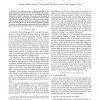Free Online Productivity Tools
i2Speak
i2Symbol
i2OCR
iTex2Img
iWeb2Print
iWeb2Shot
i2Type
iPdf2Split
iPdf2Merge
i2Bopomofo
i2Arabic
i2Style
i2Image
i2PDF
iLatex2Rtf
Sci2ools
IROS
2008
IEEE
2008
IEEE
Motion planning for urban driving using RRT
— This paper provides a detailed analysis of the motion planning subsystem for the MIT DARPA Urban Challenge vehicle. The approach is based on the Rapidly-exploring Random Trees (RRT) algorithm. The purpose of this paper is to present the numerous extensions made to the standard RRT algorithm that enable the on-line use of RRT on robotic vehicles with complex, unstable dynamics and significant drift, while preserving safety in the face of uncertainty and limited sensing. The paper includes numerous simulation and race results that clearly demonstrate the effectiveness of the planning system.
| Added | 31 May 2010 |
| Updated | 31 May 2010 |
| Type | Conference |
| Year | 2008 |
| Where | IROS |
| Authors | Yoshiaki Kuwata, Gaston A. Fiore, Justin Teo, Emilio Frazzoli, Jonathan P. How |
Comments (0)

